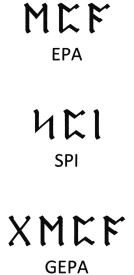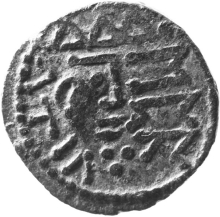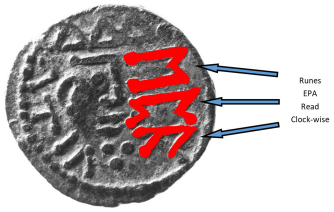“R” (Runic) Series R5 Sceatta Research
Introduction.
Determining the criteria for defining the iconography of different types/classes within the R5 group of Sceatta has not been straightforward. In T & S Vol. 3, p502 (1994), Metcalf writes “A stylistic analysis, in conjunction with chemical analyses and average weights, quickly clears the ground and shows that almost all specimens of Series R belong to one or another of about a dozen coherent and readily identifiable groups.“ However, sub-dividing the R5 group of Sceatta into types/classes doesn’t appear to be so easy.
On p511 Metcalf details some of the characteristics of the type 5 coins. He states that “Group 5, which is characterised by the legend spi,….” He also mentions a radiate crown of two triangles with pellets above the runes. The variety of symbols both outside and inside the standard on the reverse is mentioned.
Gannon, in Sylloge 63 of the British Museum Anglo-Saxon Coins p130 (2013), describes the Series R but does not specifically mention detail about the R5. In Plate 28 and its description of “Group R5 - Blackburn ‘G’ Obverse: bust with pyramidal neck with epi/spi inscriptions; straight or concave crown. Reverse various designs.” six coins are pictured with their descriptions.
Abramson in Sceatta List p65/6 (2012), describes the three types of R5 he classifies as S/1/11/60, 70 and 80. The runes SPI, EPA and XEPA are mentioned. Again, a variety of other symbols both on the obverse and reverse are catalogued.
As with the research I have undertaken into other groups of Series R Sceatta, I have decided to use Runes featured on the obverse of the flan as a major factor in defining types/classes within the R5 group. The large variety of symbols on the obverse and reverse of the flans will also feature as a contributing factor.
Forty-six coins have been scrutinised in this research. I have observed coins from images on the Fitzwilliam Museum’s Early Medieval Corpus on-line database, images from Gannon’s “Sylloge 63” of the British Museum’s collection, images from the Ashmolean Museum’s on-line database, images from Dr T Abramson’s collection and images of my own collection not registered on the EMC database.
Obverse Iconography
Runes
As mentioned above Runes feature as a major determining factor in the classifying of the coins. Twenty-eight examples have the runic combination of E P A. One coin has the runes that could be EPA or EPN. The next largest group, ten coins, have the runes S P I. The combination of X E P A, six in number, is the only other combination with more than one example. One coin has the very unusual runic combination of E A P, could this be a Die Cutter’s mistake?
One coin has runes that could be interpreted as E P N, however I think that the last letter has become corrupt either during the initial striking of the flan or from damage during its 1000 year plus burial and subsequent digging up! It could of course have been that the Die Cutter was to blame. This coin is ID 24 (Brit Mus 635). If you have access to a copy of “Sylloge 63” have a look on Plate 28/653, the third character does look like a runic N of the Anglo-Saxo Futhorc used in “England” during the first half of the eighth century. See below
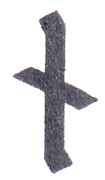
When runes are depicted on the flan of a Sceat the die cutter usually cuts them in a "Pommèe" format. Below in blue.
Some coins also have one or two pellets within the bottom two legs of the “E” rune. The “E” rune looks like a Roman capital M. See example below in blue.
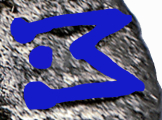
Crown on Obverse
The largest group featured a Two Point Crown. The Three Point Crown could be seen on the next largest group of coins. Only one coin had a Four Point Crown, this coin also had the very rare runic combination of EAP. Could this coin be a contemporary copy? On the remaining coins the crown was either not visible or only partially visible. Coin ID 8 (2010.0052) did not appear to have one.
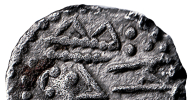

Two point Crown Three point Crown
Symbols above Runes.
A number of coins have a triangle of pellets above the runes on the obverse of the coin. Some of the flans depicted a two point crown with some featuring a three point crown. See pictures above. One coin, ID 29 has a triangle of pellets above the runes but the crown is only partially visible, however, after closer inspection I have recorded it as a three point crown. Some coins have a single pellet above the runes, some an annulet, others nothing. Two coins, ID 6 (EMC 2009.0251) and ID 37 have a triangle of pellets below and to the front of the head, is this a beard?
Symbols behind Head
There are what appears to be a multitude of combinations of symbols behind the head on the obverse, all heads face the right. It is important to note that if the strike on the flan is positioned to the left some of the iconography will be lost over the edge of the flan. The dies were cut (1300 years ago) with much less sophisticated engineering equipment than is available today by people who may not have even been literate. The Sceat is quite a bit smaller in diameter and much lighter in weight than today’s small 5p piece!
The symbols behind the head on the forty-six coins in the survey have been classified by dividing then into letters and chevrons. As the “T” is the numerically predominant feature, any coin with a “T” is included in the “T” classification. The next largest group is coins with an annulet but no “T”. The letter “A” (without a “T”) appears also. A chevron (>), without any letters, is also seen. On three coins the iconography is not clear enough to determine exactly. Only coins with clear iconography on both of the obverse and reverse have been allocated Type numbers.
Neck Lines
The large majority of the coins have beaded neck lines beneath the head on the obverse, most have three or four, a few only two. One coin has no visible neck line. One other does not have a neck line, the bottom of the head is very near to the exergual lines, this coin (ID 35) has a sloping crown line and other characteristics that may not be consistent with the iconography of an R5 coin although when I bought it I considered it might be because of the symbols in the standard. There is a coin in the Abramson Collection that is most likely a Die Match with ID 35.
One of the main criteria for inclusion in Abramson’s classification of R series “Second Block-Secondary Series” is the presence of a beaded pyramidal neck. As a consequence of this criterion I have excluded ID 35 from classification in the R5 Type numbers.
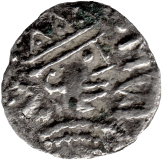
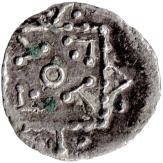
ID 35 Timms Collection
Exergual Lines
Of the forty-six coins examined, just over half have exergual lines. On one coin it was not clear. ID 35 did have lines. The lines vary from very curved to only slightly curved. Most are beaded. Many coins have a beaded border.
The largest section within the “Exergual Lines” group was those with a two point crown, just over half of these had the runic combination of SPI.
Reverse Iconography
All coins have a beaded Standard placed on the reverse flan. All have either a central annulet or pellet within the Standard. The central element in the Standard is surrounded by four symbols/letters. These consist of a combination of “T’s”, “L’s”, pellets or angled/horizontal lines.
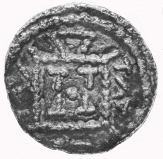
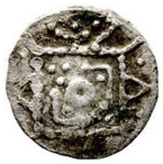
Timms Collection ID 29 Timms Collection ID 32
T’s in Standard with Central Pellet L’s in Standard with Central Annulet
Symbols/Letters in Standard
Over a half of the coins have “T’s” within the Standard. Just under a quarter have “L’s” in the Standard. One coin is too damaged to clearly determine its features precisely. ID 35 is different, it has both “T’s” and “L’s” around the central annulet, there are also two pellets as well.
Die Matches
Coins ID 4 and ID 5, runes EPA are a die match. To view images visit the EMC database online at the Fitzwilliam Museum Cambridge. Neither of these coins were allocated type numbers as the crowns were not sufficiently visible to categorise. ID 4, EMC 2000.0373; ID 5, EMC 2002.0588.
Coins ID 38 and ID 39 (both from the Abramson Collection are a die match, they both have two “T’s” and two horizontal lines within the standard. ID 38 weighs 0.80g and was found in Kings Lynn Norfolk (below left) and ID 39 (below right) weighs more, 0.97g, it was found in Cambridgeshire.
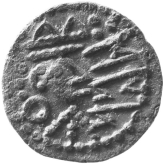
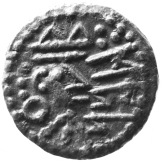
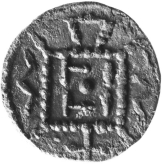
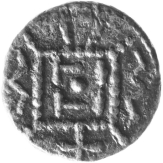
Tufa (Fantail)
Twenty-nine coins have a Tufa above the Standard, Sixteen coins do not have a tufa. One coin was too damaged to decide. Out of the Twenty-nine coins with a Tufa, more than half were in the “2 Crown” category, just over a third had a three pointed crown. A Tufa is sometimes called a Fantail. Most Tufa’s have a triangle of three pellets within them. All coins have their images shown with the Tufa at the top of the coin.
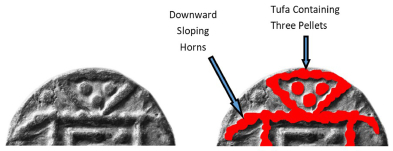
Most coins that have a Tufa at the top outside of the standard (see above), have a cross pommée on the bottom outside of the standard (see below).

Some coins have a cross pommée attached mid-point on each of the four sides of the standard. Sometimes the cross pommée is unbarred. There are a variety of symbols/letters to the left and right sides of the standard. Some have “T۸T” mirrored each side, sometimes the “T’s” are slightly angled. Others have what looks like two chevrons linked together “۸۸”. Just two pellets to each side can also be seen.
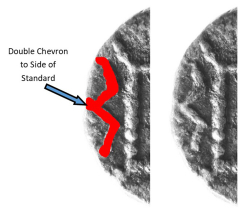
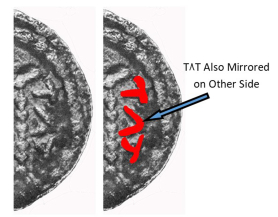
Corner lines
Most standards have an angled corner line pointing outwards at about 45°. Very occasionally two horns can be observed hanging down from the two top corners of the standard. Some coins have a beaded border on the Reverse of the coin. See images above.
Beaded Border
The majority of coins have a Beaded Border on one or both sides. Borders appear on the one coin with a four point crown and on both of the three and two point crown coins.
Runic Combinations
The runic combinations of EPA, SPI and GEPA are shown below. On all of the R5 coins in this research the runes are depicted in front of the head/bust on the obverse flan of the coin. An example of how the runes appear on the coins is shown below, the runes are highlighted in red.
